Yo-yo
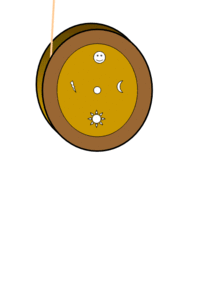 | |
| Availability | 500 BC–present |
|---|---|
A yo-yo (also spelled yoyo) is a toy which in its simplest form is an object consisting of an axle connected to two disks, and a length of string looped around the axle, similar to a slender spool. It is played by holding the free end of the string known as the handle (usually by inserting one finger into a slip knot) allowing gravity or the force of a throw to spin the yo-yo and unwind the string (similar to how a pullstring works), then allowing the yo-yo to wind itself back to one's hand, exploiting its spin (and the associated rotational energy). This is often called "yo-yoing". First made popular in the 1920s, yo-yoing remains a popular pastime of many generations and cultures. It was first invented in ancient Greece.
In the simplest play, the string is intended to be wound on the spool by hand; The yo-yo is thrown downwards, hits the end of the string, then winds up the string toward the hand, and finally the yo-yo is grabbed, ready to be thrown again. One of the most basic tricks is called the sleeper, where the yo-yo spins at the end of the string for a noticeable amount of time before returning to the hand.
Many yo-yo tricks are done while the yo-yo is said to be sleeping.[1] One of the most famous tricks on the yo-yo is "walk the dog". This is done by throwing a strong sleeper and allowing the yo-yo to roll across the floor, before tugging it back to the hand. English historical names for the yo-yo include bandalore (from French) and quiz. French historical terms include bandalore, incroyable, de Coblenz, emigrette, and joujou de Normandie (joujou meaning little toy).[2]
Etymology
Webster’s Collegiate Dictionary states that the word "yo-yo" likely derives from the northern Philippine Ilokano language word "yóyo".[3]
History
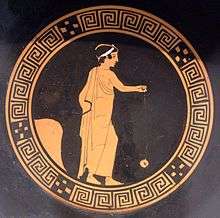
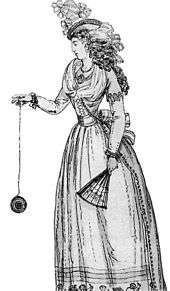
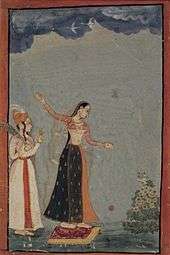
A Greek vase painting from 500 BC shows a boy playing with a yo-yo (see right).[4] Greek records from the period describe toys made out of wood, metal, or painted terra cotta (fired clay).[4] The terra cotta disks were used to ceremonially offer the toys of youth to certain gods when a child came of age—discs of other materials were used for actual play.
Birth of the modern yo-yo
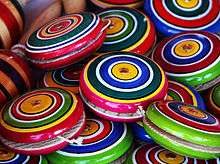
In 1928, Pedro Flores, a Filipino immigrant to the United States, opened the Yo-yo Manufacturing Company in Santa Barbara, California.[5] The business started with a dozen handmade toys; by November 1929, Flores was operating two additional factories in Los Angeles and Hollywood, which altogether employed 600 workers and produced 300,000 units daily.[5]
The principal distinction between the Filipino design popularized by Flores and more primitive yo-yos is in the way the yo-yo is strung. In older (and some remaining inexpensive) yo-yo designs, the string is tied to the axle using a knot. With this technique, the yo-yo just goes back-and-forth; it returns easily, but it is impossible to make it sleep. In Flores's design, one continuous piece of string, double the desired length, is twisted around something to produce a loop at one end which is fitted around the axle. Also termed a looped slip-string, this seemingly minor modification allows for a far greater variety and sophistication of motion, thanks to increased stability and suspension of movement during free spin.
Shortly thereafter (c. 1929), an entrepreneur named Donald F. Duncan recognized the potential of this new fad and purchased the Flores Yo-yo Corporation and all its assets, including the Flores name, which was transferred to the new company in 1932 - the same year that the name "Yo-yo" was first registered as a trademark[6] and Harvey Lowe won the first World Yo-Yo Contest in London, England.[7] In 1932, Swedish Kalmartrissan yo-yos started to be manufactured as well.[8][9][10] In 1946, the Duncan Toys Company opened a yo-yo factory in Luck, Wisconsin. The Duncan yo-yo was inducted into the National Toy Hall of Fame at The Strong in Rochester, New York, in 1999.
1960s resurgence
Declining sales after the Second World War prompted Duncan to launch a comeback campaign for his trademarked "Yo-Yo" in 1962 with a series of television advertisements.
In a trademark case in 1965, a federal court's appeals ruled in favor of the Royal Tops Company, determining that yo-yo had become a part of common speech and that Duncan no longer had exclusive rights to the term. As a result of the expenses incurred by this legal battle as well as other financial pressures, the Duncan family sold the company name and associated trademarks in 1968 to Flambeau, Inc, who had manufactured Duncan's plastic models since 1955. As of 2014, Flambeau Plastics continued to run the company.
Rise of the ball bearing
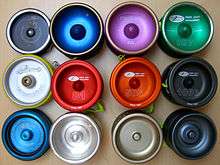
As popularity spread through the 1970s and 1980s, there were a number of innovations in yo-yo technology, primarily regarding the connection between the string and the axle. In 1979, dentist and yo-yo celebrity Tom Kuhn patented the “No Jive 3-in-1” yo-yo, creating the world's first "take-apart" yo-yo, which enabled yo-yo players to change the axle.
Swedish bearing company SKF briefly manufactured novelty yo-yos with ball bearings in 1984. Kuhn introduced the SB-2 yo-yo that had an aluminum transaxle, making it the first successful ball-bearing yo-yo.[11]
In all transaxle yo-yos, ball bearings significantly reduce friction when the yo-yo is spinning, enabling longer and more complex tricks. Subsequent yo-yoers used this ability to their advantage, creating new tricks that had not been possible with fixed-axle designs.
There are many new types of ball bearings in the market which deviate from the original design and/or material of the standard stainless steel ball bearing. For example, a certain type of bearing has an inward facing curved surface, to prevent the string from rubbing on the sides of the yo-yo, which would cause unwanted friction when performing intricate string tricks. Other manufacturers replicate this with a similar inwardly curved surface, but use minor modifications. Some high end bearings use ceramic composites in the balls of the bearing, to reduce internal friction, again making for a smoother spinning yo-yo.
Contemporary culture
Yo-yo contests
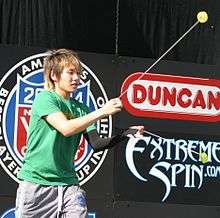
A yo-yo competition normally consists of two parts, a set of compulsory tricks and a freestyle, where points are scored for each and the winner is the yo-yo player who scores the most points. Compulsory tricks (also known as a trick ladder) are a set of tricks that have been chosen before the contest, and the competitor must successfully complete each trick on their first or second attempt to score points.
The freestyle is when the yo-yo player performs a routine to their choice of music in front of a panel of judges, and is judged based on difficulty of the tricks, synchronization with the music and artistic performance. At a National and World level, freestyles in the final round are usually 3 minutes long, with 1- or 1.5-minute semifinals and preliminary rounds.
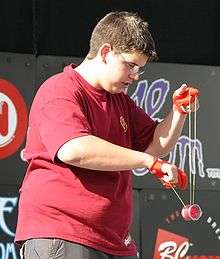
The World Yo-Yo Contest was originally held each year in Orlando, Florida, and was hosted by YoYoGuy.com during early August or late July.[12] However, in 2014, the World Yo-Yo Contest was held in Prague, Czech Republic, which was the first time the contest was held outside of North America. The 2015 Contest took place in Tokyo, Japan, and the 2016 Contest took place in Cleveland, Ohio. The 2017 Contest will take place in Reykjavik, Iceland, and the 2018 Contest will take place in Shanghai, China. The World Yo-Yo Contest takes the winners from national yo-yo contests around the world and pits them against each other. Japanese players in particular have risen to the top of the yo-yo world. The eleven-time, double-handed world champion Shinji Saito—considered the best in the world in the double-handed looping (2A) division—is Japanese.[13] Countries such as the United States, Brazil, Japan and the UK hold competitions at the national and regional levels. In addition, national yo-yo contests, without regionals, are held every year by Mexico, Taiwan, Singapore, Hong Kong, Korea, France, Germany, Switzerland, The Czech Republic, Hungary, and Australia.
In Europe, the European championship is usually held in Prague in the Czech Republic, although in 2015 it was held in Kraków, Poland. 'EYYC', as it is colloquially known, is the largest contest outside of America, and draws in competitors and spectators from all over the world. The current European Champion as of 2016 is Tal Mordoch, who is from Israel.
The TV Times world yo-yo championship was held in the United Kingdom in 1974, with heats across the United Kingdom and a final in London in 1975; the championship was sponsored by the Louis Marx toy company with the 'Lumar' brand of yo-yo. The competition was judged by a celebrity panel in each city and also Lumar demonstrator and European yo-yo champion Don Robertson. The winner of the final was Simon Harris (intermediate category). The championship was not repeated.
The youngest winner of the World YoYo contest was Takeshi Matsuura, who won the 5A division at the age of 11 in 2008. Mastuura went on to win the title in 2010, 2011, 2012, 2013, 2014 and 2016.
Contest divisions
Currently, there are six yo-yo divisions to compete in:
- 1A-The player uses a long sleeping yo-yo to perform string tricks which usually require the manipulation of the string. Currently the most popular division, with the 1A final usually being held as the last event of a contest.
- 2A-The player uses two yo-yos simultaneously to perform reciprocating or looping tricks. This tends to be the most visually entertaining style with some players incorporating acrobatics into their routines.
- 3A-The player uses two long spinning yo-yos, one tied to each hand to perform tricks that involve manipulation of the string.
- 4A-The player uses an offstring yo-yo, often releasing the yo-yo into the air and attempting to catch it on the string.
- 5A-The player uses a yo-yo with a counterweight on the other end of the string rather than having it attached to a finger.
- AP-This is Artistic Performance where the yo-yoer uses any type of yo-yo or other prop in order to perform a freestyle.
Competitors usually bring a number of yo-yos to the performance stage with them to allow for mid-routine replacements in the case of knots/jams (common with string tricks), string breakage (common with looping tricks), or drops (common with offstring tricks).
- 2008 World Yo-Yo Contest Results for 1A - 1st. John Ando (USA) 2nd. Hiroyuki Suzuki (Japan) 3rd. Sebastian Brock
- 2009 World Yo-Yo Contest Results for 1A - 1st. Shinya Kido 2nd. Hiroyuki Suzuki (Japan) 3rd. Chris Fraser
- 2010 World Yo-Yo Contest Results for 1A - 1st. Jensen Kimmitt (USA) 2nd. Hiroyuki Suzuki (Japan) 3rd. Christopher Chia (Singapore)
- 2011 World Yo-Yo Contest Results for 1A - 1st. Marcus Koh (Singapore) 2nd. Sebastian Brock 3rd. Gentry Stein (USA)
- 2012 World Yo-Yo Contest Results for 1A - 1st. Hiroyuki Suzuki (Japan) 2nd. Marcus Koh (Singapore) 3rd. Christopher Chia (Singapore)
- 2013 World Yo-Yo Contest Results for 1A - 1st.Janos Karancz (Hungary) 2nd.Christopher Chia (Singapore) 3rd.Luis Enrique Villasenor (Mexico)
- 2014 World Yo-Yo Contest Results for 1A - 1st. Gentry Stein (USA) 2nd. Takeshi Matsuura (Japan) 3rd. Iori Yamaki (Japan)
- 2015 World Yo-Yo Contest Results for 1A - 1st. Zach Gormley (USA) 2nd. Shion Araya (Japan) 3rd. Iori Yamaki (Japan)
- 2016 World Yo-Yo contest Results for 1A - 1st. Shion Araya (Japan) 2nd. Yamato Murata (Japan) 3rd. Zach Gormley (USA)
Techniques
Sleeping
The Sleeper is one of the most common yo-yo throws and is the basis for nearly all yo-yo throws other than looping. Keeping a yo-yo spinning while remaining at the end of its uncoiled string is known as sleeping. While the yo-yo is in the "sleeping" state at the end of the string, one can then execute other tricks like "walk the dog", "around the world", or the more complex "rock the baby".
The essence of the throw is that one throws the yo-yo with a very pronounced wrist action so that when the yo-yo reaches the end of the string it spins in place rather than rolling back up the string to the thrower's hand. Most modern yo-yos have a transaxle or ball bearing to assist this, but if it is a fixed axle yo-yo, the tension must be loose enough to allow this. The two main ways to do this are (1), allow the yo-yo to sit at the bottom of the string to unwind, or (2) perform lariat or UFO to loosen the tension. When one decides to end the "sleeping" state, one merely jerks the wrist and the yo-yo "catches" the string and rolls back up to the hand. Ball-bearing yo-yos with a "butterfly" shape, primarily used for string tricks, frequently (but not always) have low response (or are, in fact, completely unresponsive), requiring a "bind" for the yo-yo to return.
In competition, mastery of sleeping is the basis for the 1A division. Inexpensive fixed-axle yo-yos usually spin between 10–20 seconds, while expensive ball bearing yo-yos can spin about 1–4 minutes depending on the throw [14] As of 2010, the world record sleep times were 3:51.54 minutes for fixed-axle and 21:15.17 minutes for transaxle yo-yos.[15] In 2012, the transaxle yo-yo sleep time record was broken by the C3YoyoDesign BTH, with a time of 30:28.30 minutes.
Looping
Looping is a yo-yo technique which emphasizes keeping the body of the yo-yo in constant motion, without sleeping.[16]
Yo-yos optimized for looping have weight concentrated in their centers so they may easily rotate about the string's axis without their mass contributing to a resistance due to a gyroscopic effect.
In yo-yo competitions, looping plays a strong role in the 2A division. Looping both to the inside and outside of the hand with the yo-yo.
Off-string
In the "off-string" technique, the yo-yo's string is not tied directly to the yo-yo's axle, and the yo-yo is usually launched into the air by performing a "forward pass" to be caught again on the string. However, some players can 'throw down' off-string yo-yos and catch it on the string just as it leaves the end of the string by pivoting the string around a finger as it unwinds, so that the yo-yo is caught on the string. This is exactly the opposite of a "forward pass", but with the same result.
Yo-yos optimized for off-string tricks have flared designs, like the butterfly shape, which makes it easier to land on the string, and often have soft rubber rings on the edges, so minimum damage is inflicted on the yo-yo, the player, or anyone who happens to be standing nearby, should a trick go wrong.
Yo-yo competitions have the 4A division for off-string tricks.
Freehand
In freehand (5A) tricks, the yo-yo's string is not tied to the player's hand, instead ending in a counterweight. The counterweight is then thrown from hand to hand and used as an additional element in the trick.
Developed in 1999 by Steve Brown, as of 2008 freehand is considered to be the fastest-growing style of yo-yo play. Steve Brown was awarded a patent on his freehand yo-yo system, which was assigned to Flambeau Products (Duncan's parent company).
In yo-yo competitions, counterweight yo-yos are emphasized in the 5A division.
Shapes
-

Imperial yo-yo shape
-

Modified yo-yo shape
-

Butterfly Shape yo-yo
-
H-Shaped yo-yo
Traditional shapes
Yo-yo bodies come in a number of form factors or "silhouettes," each designed with specific advantages in mind. However, there are three popular configurations.
Modified
The modified shape is a very popular design for looping style tricks. This shape is also known as a flywheel or modern shape. It usually has a hollowed face (sometimes covered with paper or plastic) with extra material left in the rim. The modified shape yo-yo is also used for string tricks because of the long spin times due to its shape.
Butterfly
Duncan released its first wooden butterfly yo-yo. Wayne Lundberg, the inventor, was one of the demonstrators.[17] The butterfly looks a bit like the separated halves of a standard yo-yo that have been reconnected back-to-back. The wider string gap to make it easier to catch the yo-yo body on the string. Although the butterfly shape is good for 'string tricks,' it is not good for 'looping' tricks, because the winged shape of the body does not allow it to easily flip while looping. This shape is similar to a small Diabolo, sometimes called a Chinese yo-yo.
Modern shapes
Almost all new modern yo-yos have a shape that is shallow near the bearing and then widens out towards the edges (similar to the original butterfly design). The area between the rims of the yo-yo which leads down the bearing is known as the 'catch zone'. Whist there are a numerous amount of different variations in design, a lot of modern shapes can be labeled in one of the following categories.
V shape
The V shape is one of the most basic yo-yo shapes. Starting with a low wall, close to the bearing, it rises straight up and out to the edges, with no steps or other distortions. The catch zone resembles a steep V shape, hence the name.
The V shape allows for a very open catch zone that makes landing the yo-yo on the string with accuracy a lot easier.
W shape/stepped V
The W shape, also known as the 'stepped V', is when the walls of the yo-yo start close to the bearing, as in the V shape, but as they move up and out towards the rim, they change angle at one or several points. This can allow for a smaller yoyo diameter without the yoyo having to be excessively wide.
O shape/organic
The O Shape, also known as the 'organic' shape, uses curving walls that curve outwards towards the edges, similar to the older designs. Organic yo-yo's strength is that they are normally very comfortable to hold.
H shape
The H shape features rims of the yo-yo that are noticeably pronounced into the catch zone. This design gives maximum rim weight, and therefore maximum stability, although this can come at the cost of speed.
Weight distribution
Each silhouette may have more weight distributed at either the center of the yo-yo or the edge. More weight towards the rim will make the yo-yo more stable, meaning that it is less likely to tilt during play. The trade off is heavily rim weighted single-metal throws tend to play slower and heavier than more center weighted designs. Using other metals in construction can allow more weight at the rims whilst still keeping the overall weight down, which helps to give a yo-yo the best of both worlds.
Yo-yos with a higher moment of inertia will have more angular momentum when spinning at a given speed, and thus will spin freely for a longer period.
Body
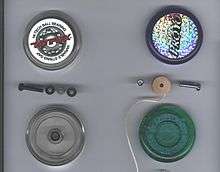
Most modern yo-yos are made from a "take-apart" design, designed to be taken easily apart and reassembled by the player. This design was first created by Tom Kuhn. This enables the replacement of yo-yo components, including the string, renewable friction sources, or even trans-axle components.
In order to increase spin times, extra weight was added to the outermost portion of the yo-yo. The first to do this was Dale Oliver (Spintastics Skill Toys, Inc) with the addition of steel rings when he brought out the Tigershark yo-yo early in 1998.
Some take-apart designs allow the player to reconfigure the yo-yo's halves. In the Tom Kuhn No Jive 3-In-1, the halves may be attached in three different configurations, resulting in a traditional, butterfly, or "pagoda" silhouette. In the Yo-yo Factory FlyMaster, the body has two different "shells" to convert to and from an off-string yo-yo.
Some yo-yos have a response system implemented in their body, which betters the ability of the yo-yo to return to the user's hand. The return system is typically positioned around the axle in the inside of the yo-yo. Some take-apart yo-yos have replaceable return systems.
Another innovation to the yo-yo is the ability to adjust the gap between the two halves of the yo-yo, in order to increase or decrease response. In most designs, this is accomplished by twisting the yo-yo halves, but some designs (such as the Tom Kuhn Silver Bullet) can be disassembled for adjustment without twisting. This second option eliminates the possibility of the yo-yo coming out of adjustment during play.
- John Jerome McAvoy, Jr. was awarded patents for the gap-adjustable yo-yo: patent #5389029 on February 14, 1995, and #6066024 on May 23, 2000.[18][19]
- In 1998, HSPIN launched the Handquake series of yo-yos, which sported an adjustable gap by using shims of 0.1-0.5mm thickness. By adding or removing shims, the gap could be widened or shrunk by +/- 1mm.
- Harry Baier (creator of the "Mondial" yo-yo) and the Flambeau Products Company (owner of Duncan) were awarded patent #6162109 on December 19, 2000 for a gap-adjustable yo-yo which has discrete positions for specific gap widths. This patent was first implemented in the CameYo Mondial before being bought by Duncan.[20]
- YoYoFactory's productline of Speed Dial yo-yo's feature "Fully Adjustable Starburst Technology" which allow the gap to be adjusted using a dial on the yo-yo. This allows for a more discrete response setting that stays the same after the yo-yo is taken apart and put back together.[21]
Axle/bearing differentiation
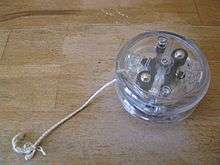
The basic innovation since the 1990s is the transaxle, a system where the string is not directly connected to the axle that connects the two halves of the yo-yo.
- Fixed axle yo-yos are represented by the original yo-yo design popularized in the first half of the 20th century, where the axle is directly connected to the string and halves of the yo-yo body. In order to enable the throwing of a "sleeper", the player must ensure the string is not wound too tightly around the axle, because it must freely spin in order to accomplish this move. Yo-yos designed for "looping" tricks tend to be fixed-axle yo-yos.
- Some more exotic fixed-axle yo-yos have axles made from low-friction materials such as ceramic alloys—this allows for easier "sleeping," which is essential for string tricks.
- The majority of trick yo-yos sold are bearing transaxle yo-yos. In these transaxle yo-yos the string is not connected to the axle directly, but rather it is wrapped about a ballrace bearing. The bearing, in turn, surrounds the true axle of the yo-yo. In this way, the body of the yo-yo may spin freely about the string's point of contact.
- There are transaxle systems which do not use a ball bearing, such as the Duncan ProFire and Yomega Fireball. These use a low-friction metal or plastic collar around the axle.
- The clutch transaxle, innovated by Yomega with the Yomega Brain, is a transaxle that can be engaged or disengaged.
- the Yomega Brain is a centrifugal clutch transaxle-- when spinning at a sufficiently high speed, counterweights inside the yo-yo body disengage the axle, automatically allowing the yo-yo to "sleep." Conversely, when the speed slows below the threshold, the yo-yo will return automatically.
- Other clutch transaxles feature a manual switch which can engage or disengage the axle.
Hubstacks
Hubstacks are bearings added to the hub (the outside) of a yo-yo and covered with some form of side cap to allow the yo-yo body to be held while it spins. With the side cap bearing, the operator can hold the yo-yo in many different planes and perform different styles of tricks which are difficult (or impossible in some cases) to be performed with conventional yo-yos. These configurations may be called hubstacks, bearing caps, synergy caps, or jimmy hats.
Physical mechanism
When the yo-yo is first released, the throw gives it translational kinetic energy. As the string unwinds, much of this energy is converted into rotational kinetic energy, causing the yo-yo to spin rapidly. As the yo-yo unwinds, it also gains some energy from gravity. Because the yo-yo has significant rotational inertia, it can store enough energy in its rotation to fight gravity all the way back up to the hand.
The string winds in the opposite direction upon the return of the yo-yo. If the string is connected to the shaft with a loop, there may not be enough friction to overcome gravity and begin winding the string. In this case, the yo-yo will continue to spin at the end of the string instead of returning. However, if the yo-yo is jerked slightly, it will enter free fall for a brief moment, and the string's friction becomes the most significant force on the yo-yo. This allows the slack string to bind, and the energy from the yo-yo's rotation finishes the rest of the return.
Patents have been issued to create more complicated mechanisms to allow tension control and an adjustable mechanism.[22][23]
See also
References
- ↑ Easy Yo-Yo Tricks, Editors of Publications International, Ltd., howstuffworks.com
^ Advanced Yo-Yo Tricks for Kids, Editors of Publications International, Ltd., howstuffworks.com - ↑ "National Yo-Yo Museum, California". Nationalyoyo.org. Archived from the original on May 13, 2008. Retrieved 2010-01-17.
- ↑ "Yo-yo; Origin of YO-YO". Merriam-Webster. Retrieved 23 December 2014.
- 1 2 Miller, Stephen G. (2004). Ancient Greek Athletics. Yale University Press. pp. 169–. ISBN 9780300115291. Retrieved 19 March 2013.
- 1 2 Pedro Flores, National Yo-Yo Museum, archived from the original on January 20, 2008, retrieved 2008-02-18
- ↑ Online Etymology Dictionary. Etymonline.com. Retrieved on 2012-04-09.
- ↑ Hopkins, Michelle (2009-04-19). "'Great ambassador' passes away". Richmond News. Retrieved 2009-04-12.
- ↑ "Kalmartrissan" och andra "trissor", County Museum of Kalmar (Swedish)
- ↑ "Kalmartrissan snurrar vidare", Dagens Nyheter 19 December 2012 (not available in the on-line edition) (Swedish)
- ↑ Kalmartrissan fyller 70 år, Sveriges radio, 25 January 2002, retrieved 22 March 2013 (Swedish)
- ↑ Classic Toys: The Yo-Yo. Retro Planet (2009-05-12). Retrieved on 2012-04-09.
- ↑ "Home of the National Yo-Yo Contest, National Yo-Yo Museum and National Yo-Yo League". National Yo-Yo. 2010-04-27. Retrieved 2011-05-23.
- ↑ Tzeng, Grace. "Toy Story: Gravity-defying yo-yo tricks on display at California State Yo-Yo Championships". AsianWeek. Retrieved on 8 September 2008.
- ↑ Yo-Yo Basics, howstuffworks.com.
- ↑ American Yo-Yo Association website.
- ↑ Science News, Week of April 17, 2004; Vol. 165, No. 16, p. 250 Archived April 20, 2008, at the Wayback Machine.
- ↑ Team Offstring Superheroes, October 17, 2008.
- ↑ U.S. Patent 6,066,024 Filed August 4, 1998; Issued May 23, 2000
- ↑ U.S. Patent 5,389,029 Filed April 27, 1993; Issued February 14, 1995
- ↑ U.S. Patent 6,162,109 Filed October 29, 1999; Issued December 19, 2000
- ↑ http://www.YoYoSkills.com/hans-interview.html - Interview with Hans Van Dan Elzen, YoYoFactory
- ↑ U.S. Patent 6,331,132 Filed July 27, 1999; Issued December 18, 2001
- ↑ U.S. Patent 7,192,330 Filed October 29, 1999; Issued December 19, 2000
